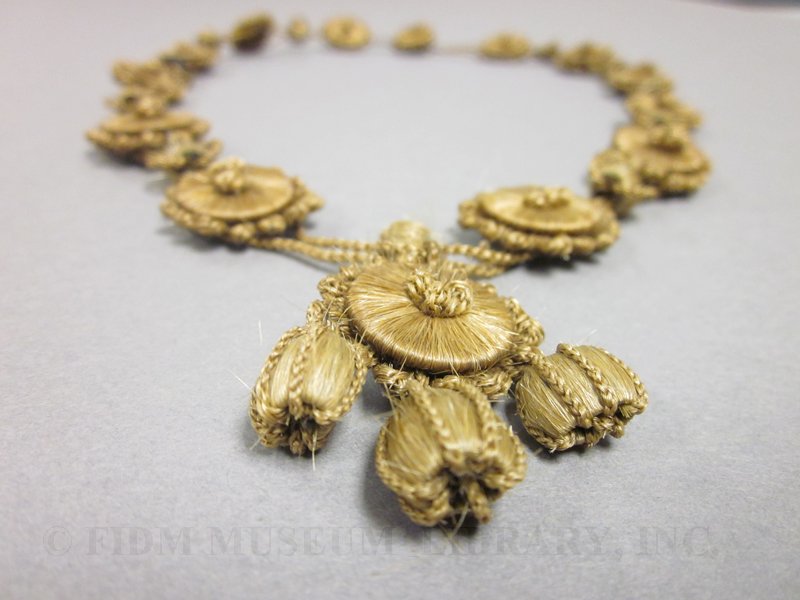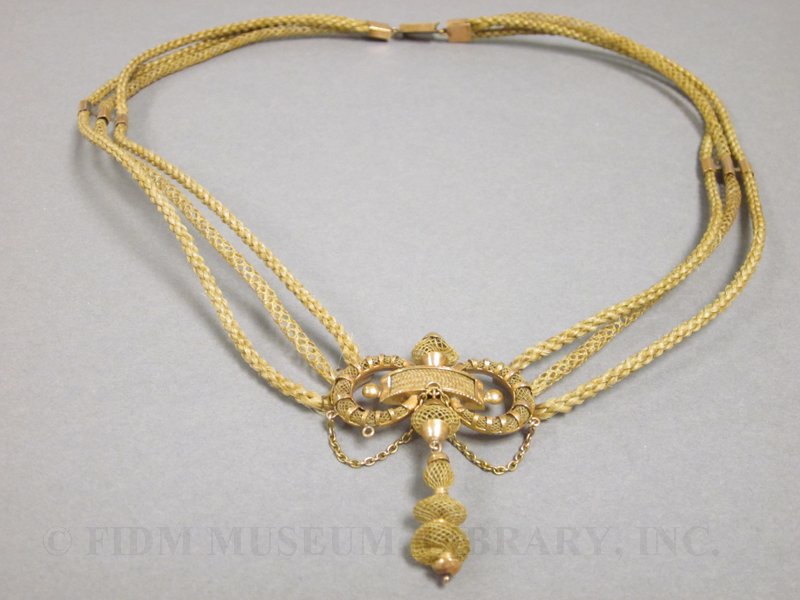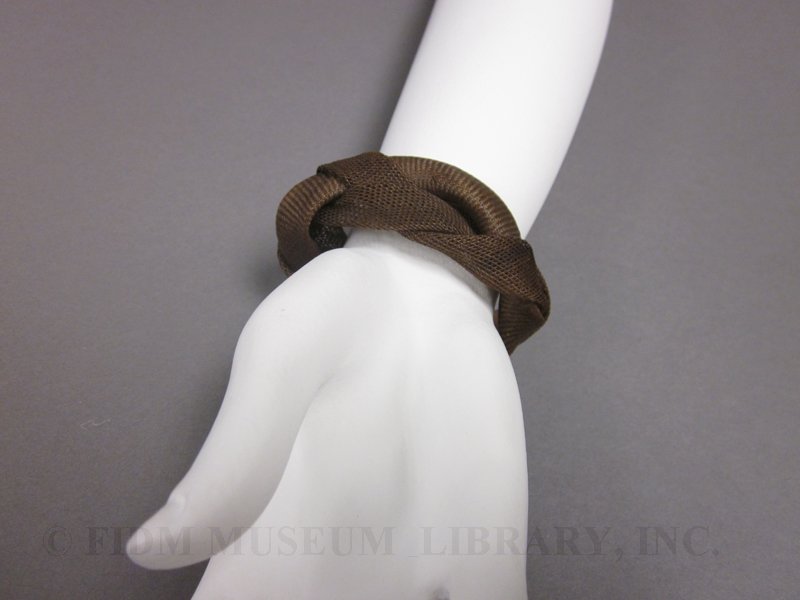Hairwork jewelry
"As the hair is the only part of our beloved friends which can be kept in memoriam, it is natural that we should desire to preserve the treasure in some manner that will testify our appreciation of its value..." -Ladies' Fancy Work, 1876.
Locks of hair have long served as sentimental and tangible reminders of deceased or far-away friends and close relations. Among family, friends and romantic partners, exchanging a lock of hair was a sign of mutual esteem and deep affection. Upon the death of a loved one, locks of hair were often cut and kept as a way to both honor and remember the dead. As suggested by the opening quote, hair degrades very slowly if carefully stored. Thus, hair was both an intimately personal souvenir of a specific person and an (almost) everlasting memento. Objects made of human hair also served as memento mori, or reminders of the transiency of human life, for those who wore or owned them.
In its most basic form, a hairwork memento consisted of a snippet of hair enclosed inside a locket or ring. In these instances, the hair was simply stored inside an item of jewelry. There are also examples of hair used as a medium for creating two-dimensional pictorial and abstract images, such as this late 19th century panel featuring both hairwork patterns and an image of the deceased. The most fascinating examples of hairwork consist of elaborate jewelry made almost entirely out of human hair. This type of hairwork jewelry enjoyed peak popularity from the 1850s through the 1880s, dying out almost entirely by the early years of the twentieth-century.
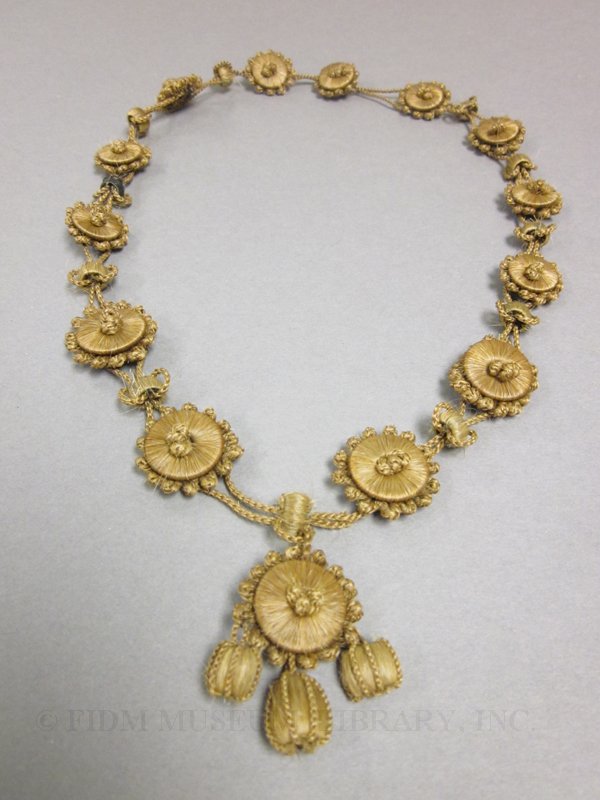
Hairwork necklace
1850-1890
Gift of Andrea Tice
2008.46.101
In the close-up image of the pendant, you can see pieces of hair which have come loose from the overall structure. This piece is a combination of hairwork forms: circular medallions are accented by a thin strand of braided hair. The entire necklace is even strung on a chain of braided hair! The medallions and bell-shaped pendants were formed by carefully wrapping hair around a solid under structure. This technique forms nearly all non-braided elements of hairwork jewelry.
In mid-nineteenth century American periodicals, intricate hairwork jewelry was identified as relatively recent innovation and a cultural import. As noted in an 1853 article describing a display of hairwork (including a tea set!) at the 1851 Crystal Palace exhibition, "...the old style of wearing a friend's hair in a locket has been common enough from time immemorial, but it is a very modern fashion to so braid and form the hair as to make not only an outside ornament of itself, but also to produce the most beautiful and delicate effect."1 A November 1850 how-to article in Peterson's Magazine called hairwork "a recent importation from Germany."2 Other sources suggest that hairwork jewelry was first created in Norway or Sweden. Regardless of its origins, this form of handwork probably came to North American during the waves of nineteenth century European immigration.
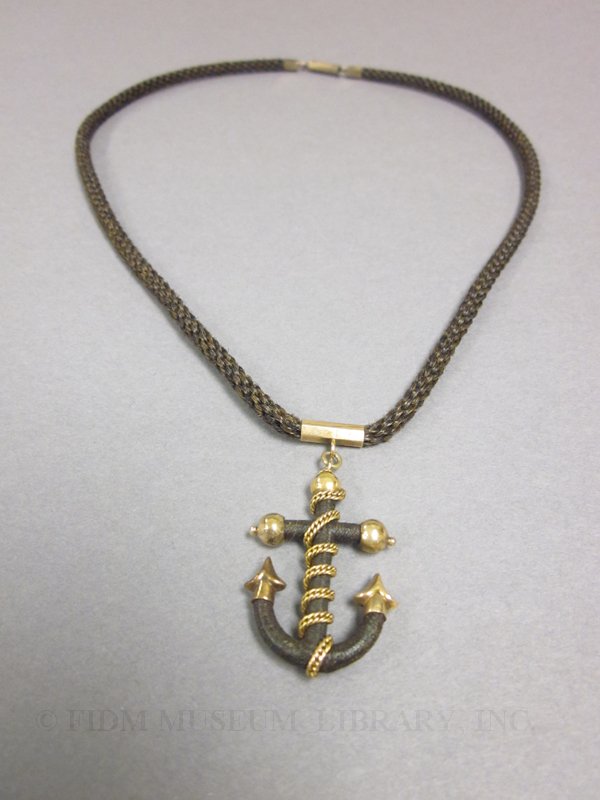
Hairwork necklace with anchor
1850-1890
Gift of Andrea Tice
2008.46.111
Hairwork jewelry often incorporated symbolic imagery, such as the anchor seen above. Though finished with gold, both the chain and the anchor are made from hair. Due to their practical function in anchoring boats in harbor, anchors are logically associated with safety. Within Christian symbolism, anchors are also associated with hope. Incorporated into a memorial hairwork necklace, an anchor possibly signified a wish that the deceased and the wearer would meet again in the afterlife.
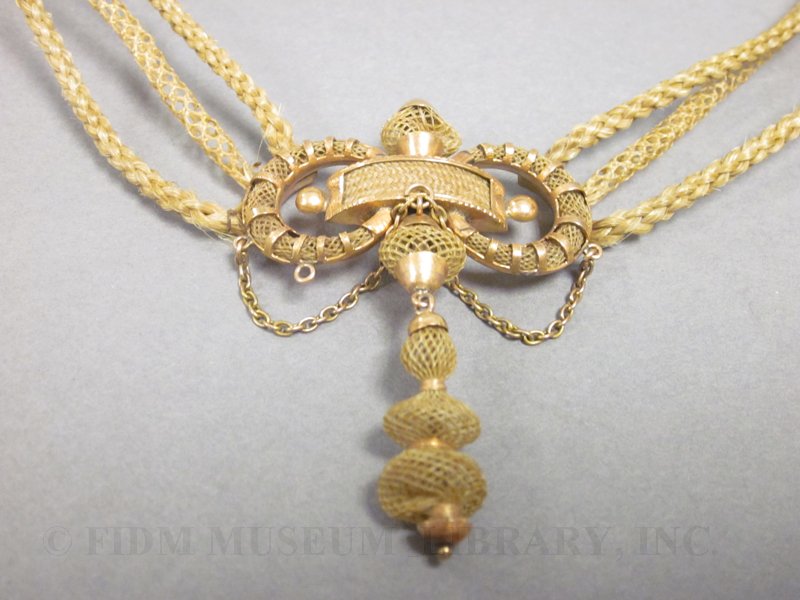 Hairwork necklace detail
Hairwork necklace detail
1850-1890
Gift of Andrea Tice
2008.46.106
The hair and gold pendant is in the form of a love knot, symbolizing the fidelity of lovers. This necklace was probably a lover's token and not an item of mourning jewelry.
The manufacture of hairwork jewelry mirrored the arc of nineteenth century industrialization. At the beginning of its popularity, hairwork jewelry was created by skilled craftsmen who usually worked independently or were affiliated with a jeweler. The skill required to work with individual strands of hair is clearly demonstrated by the images above. Operating on a relatively small scale, hairworkers created made-to-order necklaces, brooches, bracelets and other jewelry from the hair of a specific individual, for a specific customer. As hairwork grew more popular, larger jewelers began making hairwork jewelry. When made by a large firm, hairwork jewelry became simply another product to sell, rather than a prized, one-of-a-kind sentimental memento commemorating a loving relationship.
 Hairwork bracelet
Hairwork bracelet
1850-1890
Gift of Andrea Tice
2008.46.424
The band of this bracelet is made of braided hair supporting a gold locket containing a faint image of an unknown woman.
For those interested in hairwork as an at-home handcraft, fashion periodicals published how-to articles on creating hairwork. An 1876 manual titled Ladies' Fancy Work, Hints and Helps to Home Taste and Recreations included hairwork instructions. To get started with an at-home hairwork project it was necessary to procure small scissors, a knife, a spatula and several camel hair brushes, among numerous other items. Materials required included fine wire, liquid gum, india ink and the hair itself. Before use, hair (presumably from a friend or relative, though it was possible to purchase hair) had to be washed and carefully dried to avoid tangling. The hair was then separated into small bundles to be worked into braided chains of various designs. As in making some types of lace, the thin bundles of hair were tied to small weights during the braiding process and worked on a small, round table. Gold finishes, clasps, charms, etc., were purchased from a jeweler.
Given the difficulty of working with such a fine and flighty medium, an interested amateur would have needed hours of practice to complete even a simple hairwork braid. If you're inclined to add hairwork to your repertoire, take a look at Self-Instructor in the Art of Hair Work. First published in 1867, this manual purports to reveal professional techniques for creating both hairwork jewelry and fashionable hairstyles.
1 "Specimens of Hairwork." Gleason's Pictorial Drawing-Room Companion. 8 Oct. 1853: 233.
2 Mlle. Defour. "Hairwork--No. 1" Peterson's Magazine. Nov. 1850: 202.
